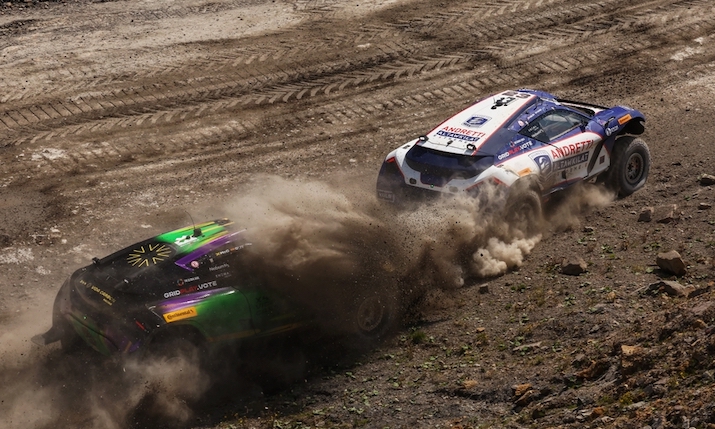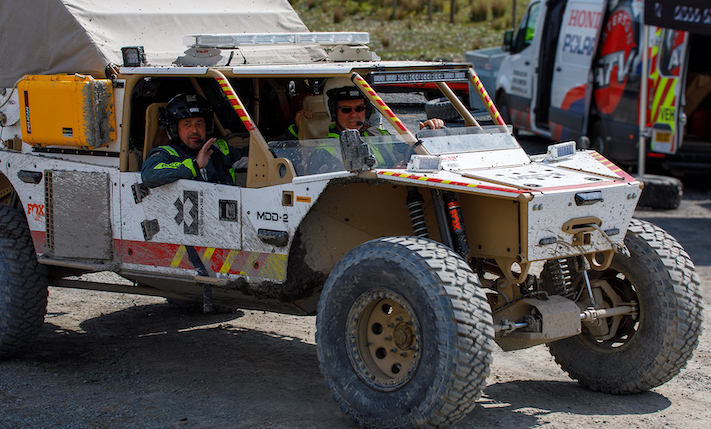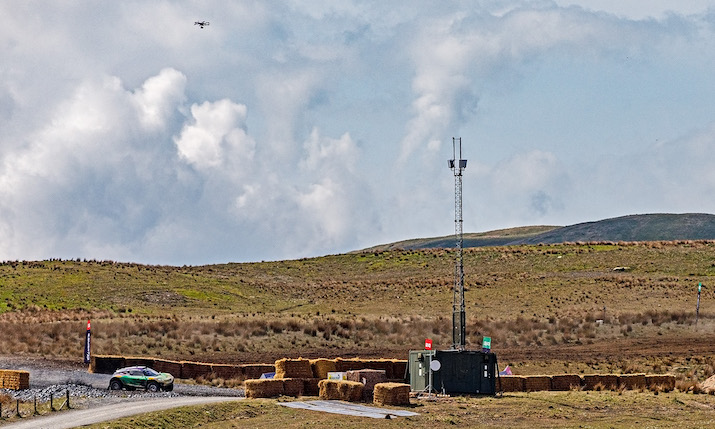Extreme E and Vodafone take 5G to the max at Hydro X Prix

Extreme E is exploring the capabilities of 5G by road testing a mobile network at its off-road electric racing events.
During the recent Hydro X Prix, which took place last month in Dumfries and Galloway in Southern Scotland, the electric racing championship ran a proof of concept of its 5G mobile private network (MPN) in conjunction with Vodafone Business.
According to Extreme E’s head of broadcast and technology Dave Adey, the technology, with its high bandwidth and low latency, offers many opportunities for the race, including health and safety, enhanced comms, sustainable transport, as well as a better way to broadcast its races and engage fans.
“It’s working very well,” Adey tells SVG Europe when we visited the Scottish event. “It was a great experiment in Uruguay [in 2022], and we’ve had some fantastic results here.”
Adey says the most advanced use so far has been seen with the medical team. “We are streaming via our 5G private network to the medical cars, so they can see and anticipate any accident rather than just waiting to hear for a call from race control,” Adey explains. “At the same time, the medics have a body cam which is connected to Proximie, a medical collaboration tool.”

5G has enabled a remote medical triage solution to be used to quickly assess any patients. Photo: Michael Burns
From the body-mounted cameras, on-the-ground footage of accidents or incidents is captured and ingested into the Proximie system with video feeds delivered simultaneously to race control and emergency vehicles fitted with 5G tablets.
“While the medics can be up close and personal with a driver, our chief medical officer and the medical team in the paddock can be on the other end of that stream, see what’s going on and ask questions,” Adey explains. “So it’s sort of ‘FaceTime’ for medical triage.”
The benefit of this remote triage solution is that Extreme E can bring in specialist triage trauma specialists from other hospitals if required, as one might add in participants to a Zoom call.
“This is all done over the 5G network,” says Adey. “That gives us a little bit of extra time. Rather than getting the driver out of the car, back on the recovery vehicle and back to the paddock, and then potentially on to a hospital, we can assess very quickly the state of the patient. That can save lives at the end of the day.”
As part of the proof of concept, Extreme E is looking at adding some additional CCTV cameras, so race control can see the whole of the track.
“We’re also experimenting with some broadcast cameras using 5G,” Adey reveals. “It provides us with an additional network, so we’re not using the RF that the cameras from the cars are currently using, or any of the data through the Al Kamel system [the provider of the RF network].”
Core container
At the highest point of the temporary racetrack in Scotland, looking down upon the deep scar of the former open-cast mine, a small shipping container is topped by a transmitter mast. This is a pop-up base station, the nerve centre of the 5G MPN. Powered by flexible solar panels which charge a Hussh Pod portable battery storage unit, the whole system has been designed with sustainability and self-reliance in mind.
Between races, when the track wasn’t ‘hot’, Ángel Colás Mosquera, global project manager at Vodafone, took SVG Europe up to view the system.
“The idea is that the whole kit, with the mast, travels with Extreme E in St Helena [the championship’s floating base],” he says.

A pop-up base station, powered by solar panels, is the nerve centre of the 5G mobile private network
Inside the container, a rack contains two slim units hosting the core 5G network and the traffic controller. Instead of a bunch of heavy cables, lightweight fibre is used to communicate with the 5G antennae on the mast. These are integrated with the radio link to reduce the footprint and power demands of the base station.
“It’s easy to mount and you just have to run the small cables. We lose much less power because we have it directly integrated on top,” Colás Mosquera explains. “We are thinking about how to productise it for the rest of the races. We’ll just put it in a Peli case and have the core network at race control, and run some fibres to the mast.”
The three antennae at the top of the mast are tilted down, to provide 5G coverage across the area of the course and paddock in three overlapping sectors.
“The thing that you have with 5G, and also 3G and 4G, is that the mobile or user equipment connects to several sectors at the same time,” Colás Mosquera explains. “It’s a seamless transition and it combines the signal, so when one sector is receiving less power, it drops it, but the signal has already connected to a new sector – or two, or three.
“We went around in a truck measuring coverage and it was really great. We had a minimum 600Mb download everywhere, with a maximum in places of around 1Gbps. For uploads, we had a minimum 60Mbps and a maximum of 100Mbps.”
Mosquera points out that normal use of the internet is concerned with streaming downloads.
“We’re testing how much we can push the uploads,” he adds. “We are seeing what the limit in the capacity is, and what can we provide to a streaming [organisation or broadcaster] for their needs.”
Colás Mosquera says by having 5G linked cameras, including inside the Odyssey 21 cars, it could provide much greater coverage than the current RF network.
“On the first day here, they plugged a professional camera into the 5G network and took one of the NEP buggies around the track,” he continues. “It transmitted at 30Mbps, with no jitter or stuttering – it was perfect. For our [proof of concept] testing we have two broadcast cameras running in broadcast quality, we have four mobile phones doing streaming video for CCTV [for race control], and we have the two cameras working in the medical vehicle, all at the same time.”
“If you plan the coverage correctly and the sectors overlap, you can have a seamless transition from one area to another without having to do a handover. You can have a bigger track with fewer repeaters around the track; you can just combine the signal to provide coverage with no dropouts and no stutter.”
Theory testing
Using the 5G MPN, Extreme E could potentially replace the infrastructure and cabling currently used by RF, not only reducing the hardware and power requirements for an organisation that is continually looking to streamline in these areas, but also providing a better mobile OB service.
“It’s a new network and more bandwidth for us to play with,” says Adey. “From our lifesaving first response to the broadcast product and improving fan engagement.”
“We’re testing how much we can push the uploads. We are seeing what the limit in the capacity is, and what can we provide to a streaming [organisation or broadcaster] for their needs”
Both Adey and Colás Mosquera stress that this, and the previous deployment in Uruguay, were still part of the trial stage. “There’s theory, and then there is practice, particularly when you get to spectrum and frequencies,” says Adey. “It is a combination of things, the proximity of your equipment to somebody else’s equipment, the proximity to the frequency that you’re on, and the power that you are broadcasting on. All these elements can confuse the theory and actually make the practice something different. So it’s a learning curve and that’s why we do these things. It was a great experiment in Uruguay, and we’ve had some fantastic results here.”
“I’m keen to understand how we can have this as a plug-and-play product in every single location,” Adey continues. “There are challenges with that, depending on where we are in terms of the available spectrum, the frequencies that we might want to use, and the availability of that 5G spectrum. So it’s not without its challenges, but if we can nail it, I’m excited to be exploring a new technology in anger.”
Partners in comms
The 5G MPN is just part of Extreme E’s partnership with Vodafone. The comms giant also sponsors the race control facility (the Extreme E Command Centre) and is providing the IoT tech to help monitor the progress of the legacy initiative here in Scotland. Extreme E launches one of these initiatives in all its racing locations, intending to reverse the impact of climate change through community engagement, education and the application of science.
Here the legacy work accompanying Hydro X Prix is in partnership with the Nith District Salmon Fishery Board, and the focus is on the health of the Atlantic salmon – a species with a steeply declining population in the past few decades. As part of the initiative, Extreme E is creating a habitat scheme and tree nursery, including planting over 1,200 trees with local schools, to reverse some of the habitat degradation. Trees stabilise the riverbanks (as the roots hold on to the soil) minimising erosion and salmon egg mortality, casting shade over the rivers and cooling the water temperature.
Graham Arnott, senior technology product owner for Vodafone Group Technology, was on hand to explain the Vodafone technology involved. “We put three types of sensors around that area [of the legacy initiative], including one in the water. This water quality monitoring buoy will tell [the fishery board] about pH acidity, the amount of silt and the turbidity, all indicators for the health of the water.
“We’ve also got sensors in the water measuring temperature and humidity. So we’re measuring ambient water and water quality of the River Nith for the first time, capturing hourly and daily data about the state of the river remotely in different places. The only other way you can do that is to take a sample every week, take that to a lab, pay for analysis and wait for the next time. Instead, we’re giving them daily data, and providing it via a platform.”
